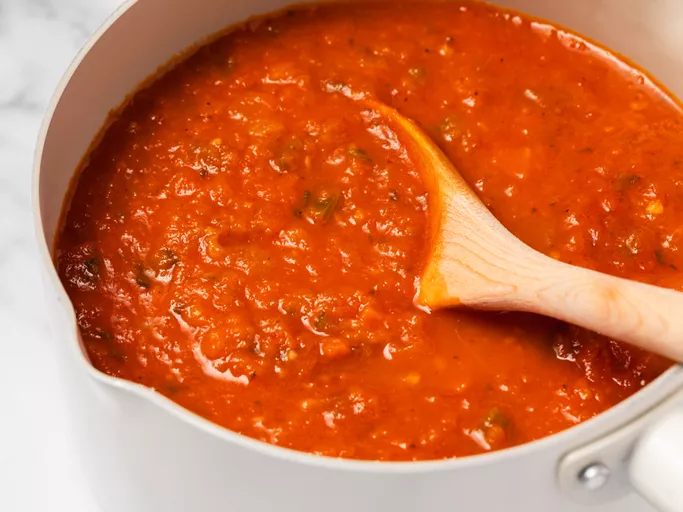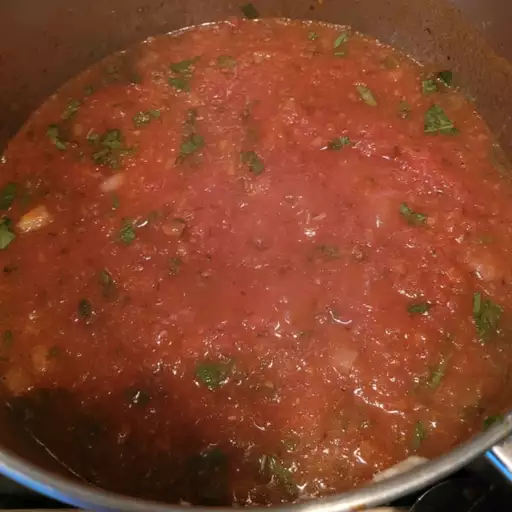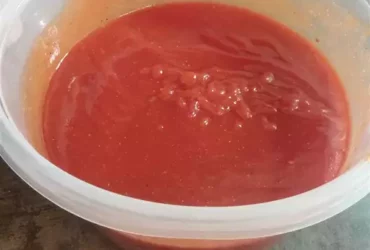Ingredients
Tomatoes: The Star of the Show
Tomatoes: The Unassuming Heroes of Your Kitchen
When it comes to cooking, few ingredients as humble as the tomato can elevate a dish from ordinary to extraordinary. At the heart of this article lies the secrets to creating an exquisite homemade tomato sauce recipe, where the star of the show is none other than the unassuming yet magnificent tomato.
The world’s most widely consumed fruit (yes, technically a fruit) has been prized for its versatility and flavor across cuisines. Whether it’s a simple salsa or a rich braise, the tomato brings an unmatched depth to any dish.
For our purpose, we’ll be using fresh, ripe tomatoes. The sweetness they contribute is essential in balancing the acidity and richness of other ingredients. You can choose from various varieties, like Cherry Tomatoes, Roma Tomatoes, or Plum Tomatoes, each lending their unique flavor profile to the sauce.
The process begins with peeling the tomatoes. You can either blanch them in boiling water, then immediately submerge them in an ice bath, or use a tool like a tomato peeler to quickly remove the skin. Once peeled, chop the tomatoes into small pieces and set aside.
The next step involves sautéing the onions until translucent, which sets the stage for adding aromatic spices and herbs. Fresh basil adds a bright, herbaceous flavor that complements the tomato’s sweetness perfectly. A pinch of salt enhances the natural flavors of the ingredients, while black pepper adds depth without overpowering the dish.
Now it’s time to bring in the acidity, which is crucial for balancing the richness of the sauce. You can use red wine vinegar or lemon juice, but keep in mind that the acidity will mellow slightly during cooking.
Adding a bit of olive oil enhances the flavor and helps to balance the heat from the spices. For an extra layer of complexity, you can include a pinch of sugar to counterbalance the acidity. The key is to taste as you go and adjust seasoning accordingly.
The sauce will thicken naturally during cooking, so feel free to add a splash of water or wine if it becomes too thick. Finally, reduce heat and let it simmer for at least 20-30 minutes, allowing the flavors to meld together in perfect harmony.
There you have it – your very own homemade tomato sauce recipe, where the tomato’s starring role shines through. Enjoy experimenting with this versatile and delicious dish!
Fresh tomatoes are essential for a rich and intense flavor in homemade tomato sauce. You can use either plum or cherry tomatoes, but the best option is to combine both for a perfect balance.
The key to making a delicious homemade tomato sauce lies in the quality and freshness of the ingredients used. When it comes to choosing the perfect tomatoes for your sauce, fresh tomatoes are essential.
There are several varieties of fresh tomatoes that can be used to make a rich and intense tomato sauce, including plum tomatoes and cherry tomatoes.
Plum tomatoes, also known as Roma or Italian plum tomatoes, are a popular choice for homemade tomato sauce because of their dense, meaty flesh and low water content. This makes them perfect for sauces that need to be thick and intense.
Cherry tomatoes, on the other hand, add a burst of sweetness and acidity to the sauce. They are also high in water content, which helps to balance out the density of the plum tomatoes.
The best option is to combine both fresh plum tomatoes and fresh cherry tomatoes for a perfect balance of flavors and textures in your homemade tomato sauce.
This combination will give you a rich, intense flavor with just the right amount of sweetness. So don’t be afraid to experiment with different combinations of plum tomatoes and cherry tomatoes to find the perfect balance for your taste buds.
Remember, the key to making a great homemade tomato sauce is to use the freshest ingredients possible, so choose the best fresh tomatoes you can find!
Crucial Supporting Actors
The foundation of a homemade tomato sauce lies not just in its primary ingredient, tomatoes, but also in the crucial supporting actors that contribute to its depth and richness.
Tomatoes are the stars of the show, providing the base flavor and texture of the sauce. Fresh or canned, they can be used depending on personal preference and available resources. For a more intense flavor, consider using a mix of tomato varieties such as plum, cherry, and Roma tomatoes.
Olive oil is another key player in this recipe, serving as the medium for sautéing aromatics and bringing out the flavors within the sauce. Choose a high-quality olive oil with a good balance of acidity and fruitiness to elevate your dish.
Onions and garlic are often the first aromatics called upon to add depth and complexity to the sauce. They are typically sautéed in olive oil until softened, allowing their natural sweetness to mellow out and blend harmoniously with the tomatoes.
Mushrooms, particularly cremini or shiitake, can be added for an earthy flavor dimension. Sautéing them alongside onions and garlic creates a rich tapestry of flavors that complement the tanginess of tomatoes perfectly.
Herbs like basil, oregano, and bay leaves bring subtle yet essential nuances to the sauce, enhancing its overall character without overpowering it. Fresh or dried herbs can be used depending on their availability and desired intensity of flavor.
Red pepper flakes add a touch of heat for those who enjoy a spicier sauce, while salt enhances the natural flavors present in each ingredient. A pinch of black pepper adds a sharpness that complements the other flavors without dominating them.
Finally, acidity from ingredients like lemon juice or red wine vinegar provides balance to the richness of the tomatoes, preventing the sauce from becoming overly heavy or cloying.
Onion, garlic, salt, black pepper, olive oil, and herbs like basil and oregano play significant roles in enhancing the flavor of your tomato sauce.
The art of crafting a rich and savory homemade tomato sauce begins with the selection of key ingredients that elevate its flavor profile.
A fundamental component of this process is the use of aromatic onions, which add a depth of flavor to the sauce when sautéed until translucent.
Caramelization is an essential step in bringing out the natural sweetness of onions, allowing them to caramelize and create a rich, sweet flavor that enhances the overall taste of the tomato sauce.
The addition of garlic also plays a crucial role in adding aroma and depth to the sauce. When sautéed with the onions, it creates an aromatic blend that sets the stage for the other ingredients to shine.
Like onions, garlic’s flavor profile is elevated through caramelization, which mellows out its pungency and adds a rich, savory taste.
Herbs such as basil and oregano are essential for infusing the tomato sauce with their distinct flavors. Fresh or dried herbs can be added towards the end of cooking to preserve their delicate flavor profiles.
The use of fresh or dried herbs allows home cooks to choose between a bright, herbaceous flavor or a more subtle, earthy undertone in their tomato sauce.
Olive oil is another vital ingredient that contributes to the overall taste and texture of the tomato sauce. Its rich flavor is enhanced through sautéing with the onions and garlic, creating a fragrant base for the sauce.
The use of high-quality olive oil adds depth and character to the tomato sauce, setting it apart from store-bought alternatives.
Finally, the judicious use of salt and black pepper is essential in balancing the flavors within the tomato sauce. A pinch of salt brings out the natural sweetness of the tomatoes, while a sprinkle of black pepper adds a subtle kick that enhances the overall taste experience.
The balance between sweet, savory, and spicy elements creates a harmonious flavor profile in the homemade tomato sauce recipe.
Instructions
The Cooking Process
- The cooking process for homemade tomato sauce involves several stages to ensure a rich and flavorful end product.
Here’s a step-by-step guide:
Step 1: Preparation
- Select the freshest tomatoes, preferably Roma or Plum tomatoes, for their sweeter taste and lower water content.
- Cut off both ends of the tomatoes and chop them into quarters to release their natural juices.
Step 2: Sautéing the Onions and Garlic
- In a large saucepan, heat 2-3 tablespoons of olive oil over medium heat.
- Add finely chopped onions (about 1 medium-sized onion) and cook until translucent, stirring occasionally.
- Next, add minced garlic (about 3-4 cloves) and sauté for another minute, being careful not to burn the garlic.
Step 3: Adding Tomatoes and Herbs
- Add the chopped tomatoes to the saucepan and stir well to combine with the onions and garlic.
- Add a pinch of salt and a few grinds of black pepper to enhance flavor.
- Crush 2-3 sprigs of fresh oregano (about 1 teaspoon) between your fingers and add them to the saucepan along with 1 tablespoon of chopped fresh basil (optional).
Step 4: Simmering the Sauce
- Reduce heat to low and let the sauce simmer for about 30-40 minutes, stirring occasionally, allowing the flavors to meld together.
- As the sauce thickens, you can help it along by mashing some of the tomatoes with a potato masher or the back of a spoon.
Step 5: Seasoning and Straining (optional)
- Taste the sauce and adjust seasoning as needed, adding more salt, pepper, oregano, basil, or even sugar to balance out the flavor.
- For a smoother sauce, you can strain it through a fine-mesh sieve or cheesecloth into another saucepan, pressing on the solids to extract as much liquid as possible.
Now your homemade tomato sauce is ready to be used in various recipes, such as pasta sauces, pizza sauces, and even as a dipping sauce for breadsticks!
Start by sautéing the onion and garlic in a pan with olive oil until they are softened. Then add the tomatoes, salt, black pepper, and herbs, and let it simmer for at least 30 minutes to allow the flavors to meld together.
To make a delicious homemade tomato sauce, follow these step-by-step instructions carefully.
First, begin by preparing the aromatics for the sauce. Sauté the onion and garlic in a pan with a generous amount of olive oil until they are softened and translucent.
This process typically takes about 5-7 minutes, depending on the heat level and the size of your onion and garlic pieces. Make sure to stir them occasionally to prevent burning.
Once the onions and garlic are softened, add in the tomatoes, along with a pinch of salt, some freshly ground black pepper, and your choice of herbs (such as basil, oregano, or thyme). You can use fresh or dried herbs, whichever you prefer.
Now, let the sauce simmer for at least 30 minutes to allow all the flavors to meld together and develop a rich, deep taste. Stir the sauce occasionally during this time to prevent it from sticking to the bottom of the pan.
As the sauce simmers, you can reduce its heat to low or even turn off the stove altogether for a few hours if needed. Just be sure to reheat it before serving. The longer the sauce sits and reduces, the thicker and more concentrated it will become.
Finally, after 30 minutes or so, taste and adjust the seasoning as necessary. You can add more salt, pepper, or herbs to suit your taste preferences.
Your homemade tomato sauce is now ready to be used in a variety of dishes, such as pasta sauces, pizza toppings, or even as a dipping sauce for bread. Enjoy!
Blending and Finishing Touches
To create an exquisite homemade tomato sauce recipe, it’s essential to follow a series of steps that ensure a perfect blend of flavors and textures.
Instructions
The first step in making a delicious homemade tomato sauce is to prepare the ingredients.
- Select fresh, high-quality tomatoes for the best flavor. You can use either plum or cherry tomatoes.
- Carefully chop the onions and garlic, as these are essential flavor components of your tomato sauce.
- Measure out the olive oil, salt, sugar, and herbs according to your recipe requirements.
Next, you’ll need to heat up a large skillet over medium heat and add the olive oil. This will create a flavorful foundation for your tomato sauce.
Blending
Once the oil is heated, it’s time to sauté the onions and garlic until they’re translucent and fragrant. This step helps to break down their cellular structure, releasing their natural oils and flavors.
- Add the chopped onions first, stirring occasionally to prevent burning.
- After a few minutes, add the minced garlic and stir well to combine with the onions.
Now it’s time to add the chopped tomatoes. You can use either crushed or diced tomatoes, depending on your desired sauce consistency. Simply pour them into the skillet, stirring gently to avoid breaking down the tomato fibers.
Finishing Touches
The final steps in creating your homemade tomato sauce involve adding seasonings and simmering the mixture until it reaches your desired consistency and flavor.
- Add salt, sugar, herbs, or spices according to your taste preferences. Some common herbs used in tomato sauces include basil, oregano, and bay leaves.
- Simmer the sauce over low heat for at least an hour, allowing the flavors to meld together and the sauce to thicken.
Once your sauce has reached your desired consistency and flavor, it’s ready to be served! You can enjoy it as is or add it to a variety of dishes, such as pasta, pizza, or lasagna.
After 30 minutes of simmering, use an immersion blender or a regular blender to puree the sauce. If you prefer a smoother texture, blend it until smooth. Season with additional salt and black pepper if needed.
When it comes to creating a delicious homemade tomato sauce recipe, following specific instructions is crucial to achieve the perfect consistency and flavor. In this case, after 30 minutes of simmering, the next step involves blending the sauce to break down the tomatoes and any other ingredients that have been added.
The instruction specifies using an immersion blender or a regular blender to puree the sauce. An immersion blender is ideal for this task because it allows for easy blending directly in the pot, eliminating the need to transfer the hot sauce to a separate container. On the other hand, a regular blender can be used if desired, but care must be taken when handling the hot mixture.
The goal of pureeing the sauce is not only to achieve a smooth texture but also to release any remaining flavors from the ingredients. For those who prefer an even smoother consistency, blending until smooth will ensure that every bite is velvety and enjoyable. However, it’s essential to note that over-blending can sometimes result in a less desirable texture or loss of flavor.
Once the sauce has reached the desired consistency, seasoning with additional salt and black pepper can be done to enhance the overall taste experience. The amount of seasoning will depend on personal preference, but starting with small increments allows for better control over the final product. This step is essential in balancing the flavors and creating a harmonious blend that complements other ingredients in dishes such as pasta, pizzas, or meat sauces.
Tips for Perfection
Reducing Acidity
To achieve perfection in homemade tomato sauce, it’s essential to focus on reducing acidity, which can make or break the flavor and texture of this beloved condiment.
One crucial step in minimizing acidity is to use a combination of tomatoes with varying levels of acidity.
This means incorporating a mix of fresh and canned tomatoes into your recipe. Fresh tomatoes tend to have a higher water content, which can help dilute the acidity found in canned tomatoes. Conversely, canned tomatoes offer a concentrated flavor and a lower pH level, which helps balance out the acidity.
Another significant factor that affects the acidity of homemade tomato sauce is the cooking process.
Aiming for a moderate heat and simmering time can help break down some of the acidic compounds present in the tomatoes. However, be cautious not to overcook your sauce, as excessive heat can lead to the formation of off-flavors and further increase acidity levels.
The role of tomato paste should not be underestimated when it comes to reducing acidity in homemade tomato sauce.
This concentrated form of tomato puree contains a high amount of solids and minimal water content, making it an ideal ingredient for minimizing acidity. When added towards the end of cooking, tomato paste can help enrich your sauce’s flavor without introducing additional acidity.
Finally, incorporating aromatic ingredients like onion, garlic, and carrots can contribute to a more balanced taste profile and help mask any remaining acidic notes in your homemade tomato sauce.
A hint of sweetness from added ingredients such as sugar or honey can also counteract acidity, creating a smoother flavor experience for the palate.
If using fresh tomatoes, you may need to add a pinch of baking soda to balance out the acidity.
To achieve perfection in your homemade tomato sauce recipe, it’s essential to start with high-quality ingredients, and that includes fresh tomatoes.
If using fresh tomatoes, you may need to add a pinch of baking soda to balance out the acidity, which can help break down the cell walls and release the natural sweetness within the tomatoes.
Begin by washing and chopping your fresh tomatoes, removing any stems or blemishes along the way. This will also give you an opportunity to inspect the quality of your ingredients.
A good rule of thumb is to use a mix of sweet and acidic tomatoes for added depth and complexity in your sauce. Some popular varieties include San Marzano, Roma, and Cherry Tomatoes.
Once you’ve prepared your tomatoes, heat a tablespoon or two of olive oil in a large saucepan over medium-low heat. This will provide a smooth base for the reduction process that’s to come.
Next, add a pinch of salt and sauté the chopped onions until translucent before adding the minced garlic and letting it cook for another minute, being mindful not to burn either ingredient.
Now it’s time to add in your fresh tomatoes, along with any additional aromatics such as bay leaves, oregano sprigs, or red pepper flakes, depending on your desired flavor profile. Stir everything together and let the sauce simmer over low heat for at least an hour, allowing the flavors to meld together.
During this time, you may need to occasionally skim off any excess water that forms on the surface of the sauce or adjust the seasoning as needed.
To perfect your homemade tomato sauce recipe, consider adding a little acidity in the form of red wine vinegar, lemon juice, or even a splash of balsamic glaze for added depth and balance. The key is to taste as you go along and adjust the seasoning accordingly.
Finally, finish off your sauce by adding in any desired herbs or spices before letting it simmer for another 10-15 minutes to allow the flavors to meld together perfectly.
Using Leftover Sauce
The key to achieving perfection with leftover sauce is to repurpose it creatively and think outside the box.
9 Creative Ways to Use Leftover Homemade Tomato Sauce
- Make a hearty Beef Stew by simmering the leftover tomato sauce with beef or lamb, vegetables, and noodles for a comforting meal.
- Transform it into a rich Pasta Bolognese by adding ground meat, simmering until thickened, and serving over spaghetti.
- Turn it into a savory Meatball Sub by mixing the leftover tomato sauce with minced meat, forming into balls, baking or pan-frying until cooked through, and sandwiching between sub rolls.
- Use it as a dipping sauce for crispy breadsticks or pizza dough for a snack.
- Add a spoonful of the leftover tomato sauce to scrambled eggs or omelets for an Italian twist on breakfast.
- Mix it with some cream and parmesan cheese to create a creamy pasta bake topping or as a side dish.
- Make individual servings of Stuffed Peppers by filling bell peppers with cooked rice, leftover tomato sauce, ground meat, and shredded mozzarella cheese, then baking until tender.
- Create a simple Bruschetta by brushing toasted bread with olive oil, topping with minced garlic, basil leaves, diced tomatoes, and spooning the leftover tomato sauce over the top.
- Use it as a base for making homemade pizza sauce or add some dried oregano, thyme, and rosemary to create an Italian-inspired focaccia bread filling.
These ideas will not only stretch your leftover tomato sauce but also inspire you to think outside the box when repurposing sauces in general. Get creative and enjoy!
Your homemade tomato sauce can be stored in an airtight container in the fridge for up to 5 days or frozen for up to 6 months.
To achieve perfection with your homemade tomato sauce, it’s essential to follow a few key tips during and after preparation. First, when cooking the sauce, ensure that you use high-quality ingredients, such as fresh, ripe tomatoes, garlic, onions, and herbs like basil and oregano. The freshness of these ingredients will directly impact the flavor and aroma of your final product.
Next, be mindful of the cooking time and temperature to avoid overcooking or burning your sauce. A gentle simmer on low heat is usually ideal for extracting the natural flavors and thickening the sauce without compromising its texture. You can also use a blender or food processor to achieve a smooth consistency if desired.
Another crucial aspect to consider is seasoning. Add salt, sugar, and acidity (like lemon juice) according to your taste preferences. Don’t be afraid to experiment with different combinations of spices and herbs to create unique flavor profiles. However, remember that less is often more – avoid over-seasoning, which can overpower the natural flavors of the tomatoes.
After preparing your sauce, it’s time for storage. As mentioned earlier, you can store your homemade tomato sauce in an airtight container in the fridge for up to 5 days or freeze it for up to 6 months. To freeze, simply pour the sauce into an airtight container or freezer bag and label it with the date. When you’re ready to use it, thaw overnight in the fridge or reheat from frozen.
To maintain the quality of your stored tomato sauce, ensure that the container is airtight to prevent contamination and spoilage. Additionally, consider freezing individual portions to avoid having to thaw the entire batch if only a small amount is needed.
- Best Datanyze Alternatives for 2025 - April 24, 2025
- Best Hunter.io Alternatives for 2025 - April 22, 2025
- Best Lead411 Alternatives for 2025 - April 22, 2025















